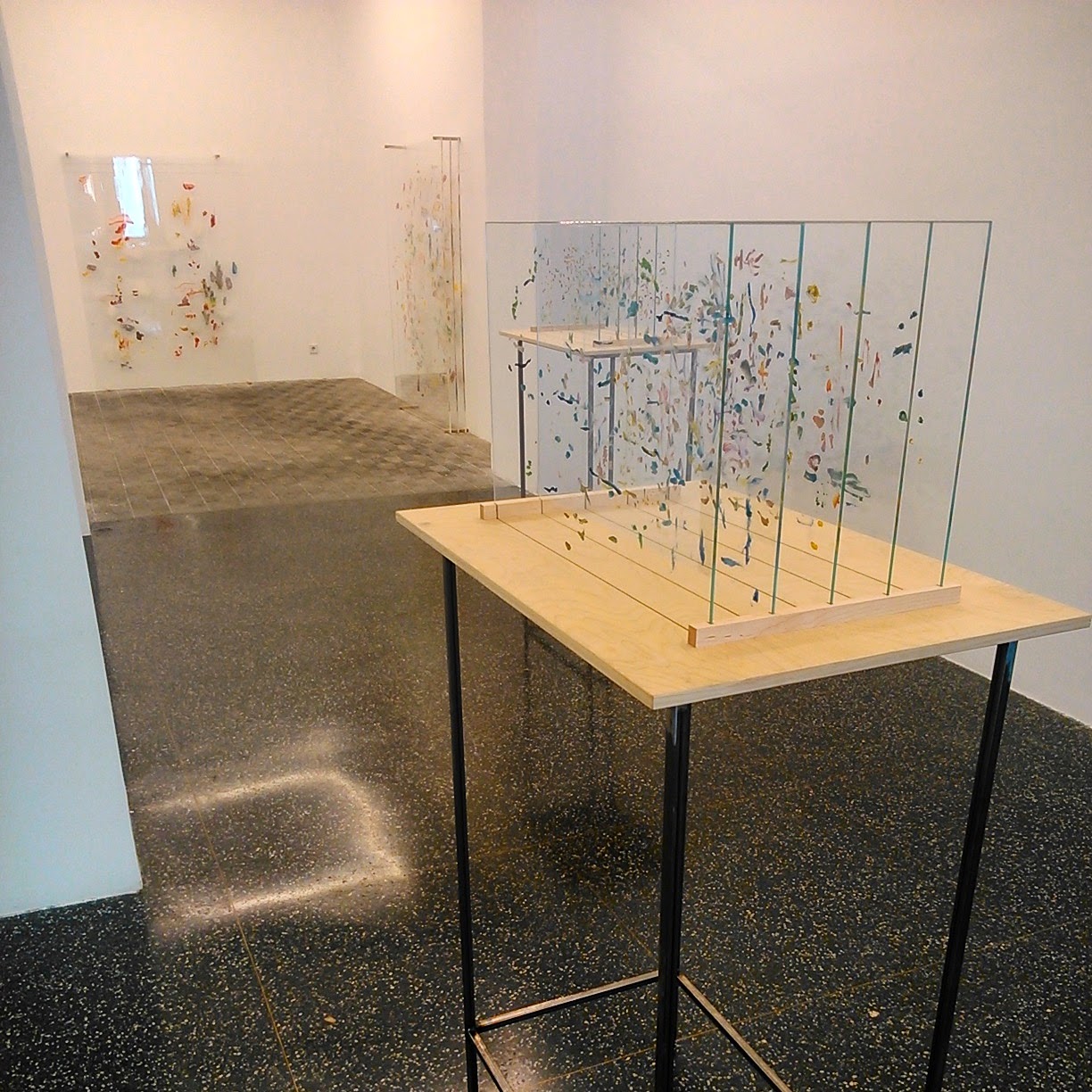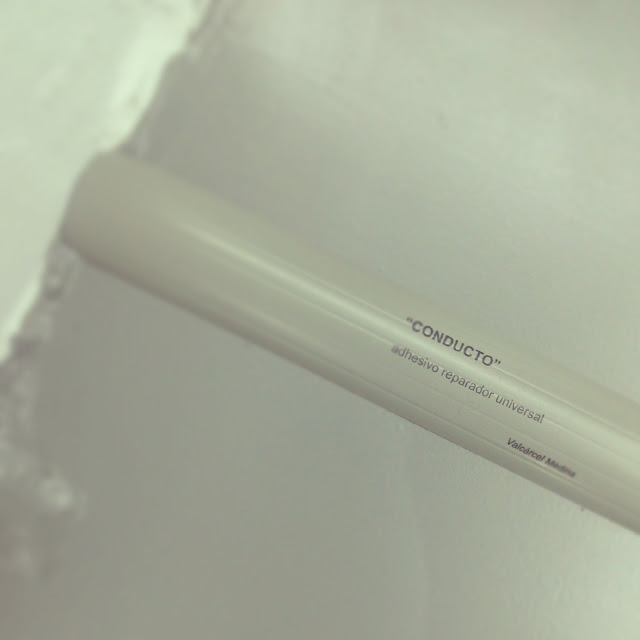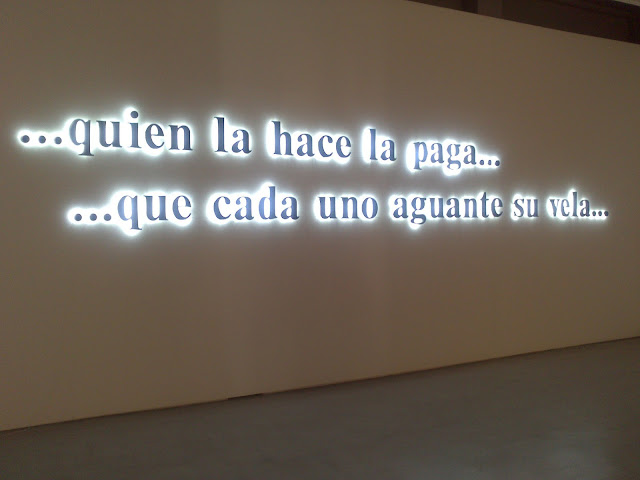Longitudes
Cover Story, December 2023: Ibon Aranberri, Partial View
Sat, Dec 2 2023December 2023 cover story on www.lttds.org
The December 2023 monthly Cover Story “Ibon Aranberri. Partial View” is now up on our homepage: www.lttds.org
“This month’s Cover Story, the 100th no less, focusses on artist Ibon Aranberri, whose anthology exhibition “Vista partial” (Partial View) has recently opened at the Museo Nacional Centro de Arte Reina Sofía in Madrid, and with whom Latitudes has been able to collaborate on several occasions.” → Continue reading (after December 2023 this story will be archived here).
Cover Stories are published monthly on Latitudes’ homepage featuring past, present, or forthcoming projects, research, texts, artworks, exhibitions, films, objects, or field trips related to our curatorial projects and activities.
- Archive of Monthly Cover Stories
- Cover Story, November 2023: Surucuá, Teque-teque, Arara: Daniel Steegmann Mangrané, 2 Nov 2023
- Cover Story, October 2023: A tree felled, a tree cut in 7, 2 October 2023
- Cover Story, September 2023: The Pilgrim in Ireland, 6 September 2023
- Cover Story, July–August 2023: Honeymoon in Valencia, 1 July 2023
- Cover Story, June 2023: Crystal Bennes futures, 1 Jun 2023
- Cover Story, May 2023: Ruth Clinton & Niamh Moriarty in Barcelona, 1 May 2023
- Cover Story, April 2023: Jerónimo Hagerman (1967–2023), 1 Apr 2023
- Cover Story, March 2023: Art, Climate and New Coalitions, 1 March 2023
- Cover Story, February 2023: Soil for Future Art Histories, 2 Feb 2023
- Cover Story, January 2023: Claudia Pagès’ ‘Gerundi Circular’, 2 Jan 2023
- Cover Story, December 2022: “The Melt Goes On Forever. David Hammons and DART Festival, 1 December 2022
- Cover Story, November 2022: Jorge Satorre’s Barcelona, 1 Nov 2022
Report from Madrid: Apertura 2014 gallery and museums programme in tweets, 11–13 September
Mon, Sep 15 2014More photos documenting the same shows we saw or others that didn't make it to the twitter for lack of time (or network):
Report from Glasgow: Lecture at The Common Guild and studio and gallery visits (4 December 2013)
Report from Paris: FIAC week, 21–28 October 2013 (5 November 2013)
Report from Athens: "AGORA", 4th Athens Biennale 2013 (4 November 2013)
Report from New York: Gramcsi Monument, visiting critics at ISCP, Carol Bove at The High Line and galleries route (23 September 2013)
Report from Dublin and Derry-Londonderry: research trip to Ireland, 8–14 March 2013 (16 March 2013)
Report from Urdaibai: commission series 'Sense and Sustainability', Urdaibai Arte 2012 (22 July 2012)
–
This is the blog of the independent curatorial office Latitudes. Follow us on Facebook and Twitter.
All photos: Latitudes | www.lttds.org (except when noted otherwise in the photo caption)
This work is licensed under a Creative Commons Attribution-NonCommercial-NoDerivs 3.0 Unported License.
La cultura en España (2a parte): estadísticas, cifras y porcentajes del 2013
Thu, Dec 19 2013Estadística de Financiación y Gasto Público en Cultura, desarrollada por el Ministerio de Educación, Cultura y Deporte. Descargar pdf aquí. |
| Estadística del empleo cultural en el 2012. Descargar pdf aquí. |
En relación al cine: El número de festivales españoles de cine han descendido dramáticamente, pasando de 80 en el 2011 a 36 un año después. Este descenso se sigue reflejando prácticamente en todas sus cifras: en millones de espectadores (98,3 millones en el 2011 a 94,2 en el 2012); películas estrenadas (511 en el 2011, 472 en el 2012), y se han producido menos cortometrajes (249 en el 2011, 228 en el 2012). El cine, no obstante, sigue siendo el espectáculo cultural con más demanda, seguido por la asistencia a espectáculos en directo.
| Estadística sobre el cine y el video. Descargar pdf aquí. En más detalle aquí. |
Más datos. Ahora libros (descargar pdf de las estadísticas). En el 2011 se inscribieron 111.907 libros en ISBN, en el 2012 han sido 104.724 (80.094 de ellos en soporte papel, 24.630 en otros soportes). 7.183 libros menos para disfrutar, y un 6.4% menos de un año a otro. En cuanto a editores, en el 2012 contamos con 96.910 editores privados, frente a 7.814 públicos (eran 104.118 en el 2011, frente a 7.789 públicos), ahí hay 7.208 editores que han terminado su actividad, y como siempre ocurre en cualquier caso, la cadena que genera de descenso de empleo para diseñadores, impresores, distribuidores y para lectores, claro está, que caen en picado.
Más llamativo es el dato que aporta el apartado 18, el titulado "Cuenta Satélite de la Cultura", cuando vemos que por sectores culturales el sector que más aporta al PIB total, es el sector de Libros y prensa, con una aportación total que representa el 38,1% en el conjunto de actividades culturales, seguido por Audiovisual y multimedia (25,9%), las Artes Plásticas (15,2%), las Artes escénicas (9,1%), el Patrimonio, archivos y bibliotecas (6,9%) y una zona gris del 5,8% perteneciente a "lo interdisciplinar" (¡a saber!). También fue el sector de los libros, quien tuvo el comportamiento más favorable del comercio exterior, con exportaciones por valor de 540,1 millones de euros (véase gráfico 6 de Comercio exterior de bienes y servicios culturales).
| Gráfico de la "Cuenta Satélite de la Cultura", descargable aquí. |
A pesar de los datos aportados por los 18 capítulos (hubo 17 en el anuario pasado, este año se ha añadido "Asuntos taurinos" como nº 17), y de encontrar datos aislados sobre el comportamiento de las artes plásticas (¡esa terminología tan demodé!), no encontramos ningún gráfico específico a las artes visuales contemporáneas.
Para completar el estudio, finalizamos aportando datos de una reveladora estadística que ha publicado recientemente el periódico El País sobre la representación de las mujeres españolas en el sistema del arte, con datos recogidos por la asociación Mujeres en las Artes Visuales (MAV). Y lo complementamos con un post publicado por NIAL Art Law sobre la obligación del Ministerio de Fomento a destinar en los contratos de obras públicas una partida de al menos el 1% (conocido como el "1% cultural") a trabajos de conservación o enriquecimiento del Patrimonio Cultural Español.
Analicemos primero el artículo de El País. Lamentablemente, en él constatamos lo que ya sabemos: que en el sistema artístico también se reproduce la estructura piramidal que existe en otros sectores profesionales. Mientras que las mujeres predominan en las carreras de Bellas Artes (65% de las titulaciones) e Historia del Arte (74%), así como en los departamentos de coordinación y conservación de numerosos museos y centros de arte (un alto 81%; o un 67% que ha pasado por oposiciones para solicitar cargos de conservación en museos públicos), pocas ocupan puestos de responsabilidad (22% son directoras de museos o centros de arte contemporáneo) o de reconocimiento profesional (ninguna mujer española ha sido, por ejemplo, galardonada con el Premio Velázquez. Y aunque ya sabemos que éste es sólo un premio de los muchos existentes, es el que mejor dotación económica tiene: 100,000 Euros en 2013).
 |
| Representación de las mujeres españolas en el sistema del arte publicado en El País. |
En cuanto a la adquisición de obra realizada por mujeres, museos como el Museo Nacional Centro de Arte Reina Sofía (MNCARS) en Madrid han ido, desde 2008, adquiriendo obra con criterios paritarios (46% mujeres y 54% hombres), aunque las cifras de su colección permanente (un 4% de obras y un 6% de artistas españolas en su colección) arrastran, como apunta el artículo, un notable desequilibrio.
Report from the 2013 congress of the International Association of Curators of Contemporary Art (IKT) in Madrid, 18–21 April
Tue, Apr 23 2013"Curating Value", the topic of this year's symposium organised by Brussels-based independent curator Zoë Gray, included the participation of Barnabás Bencsik (the recently forced-out director of the Ludwig Museum in Budapest), French artist Pierre Bismuth, Spanish curator and consultant María de Corral, London-based curator and theorist Dr. Simon Sheikh and Greek artist and Athens Biennial co-director, Poka-Yio.
Following is our photo diary documenting a few moments of these five days in Madrid alongside the organisers' schedule, starting the Pre-Congress programme on Thursday afternoon with a first meeting at Espacio Trapézio at the Mercado de San Antón and ending on Monday morning with the Post-Congress programme which included studio visits to Fernando Sánchez Castillo and Cristina Lucas.
Friday, 19th April 2013
Buses depart from Plaza del Emperador Carlos V/ Atocha (opposite the renowned El Brillante bar) for Centro de Arte Dos de Mayo (CA2M) in Móstoles.
IKT Members Forum. Opening of the congress, welcome and greetings.
Exhibition visits: Pop Politics: Activismos a 33 revoluciones curated by Iván López Munuera and Hailil Altindere curated by CA2M Director, Ferran Barenblit.
Buses depart for Fundación Banco Santander (Boadilla del Monte) to visit the exhibition "Out of the House. Contemporary Art Cranford Collection", curated by Anne Pontégnie and Muriel Salem.
Buses depart for Ivory Press. Exhibition visit: Ilya & Emilia Kabakov.
Walk to Galería Liebre. Exhibition visit: Ideas y presupuestos. Curator: Martí Manen.
Ideas and budgets for possible artworks by artists Sebastian Beyro, Black Tulip, Bonus Extra, Kalle Brolin, Priscila Fernandes, Guillem Juan Sancho, Sandra Paula Fernández, Ana García Pineda, Luis Pérez Calvo, Iratxe Jaio & Klaas van Gorkum, Laramascoto, Connie Mendoza, Carlos Motta, Carl Palm, Pepo Salazar, Yes.
Visit to the Tabacalera Espacio Promoción del Arte. Exhibition visit: José Manuel Ballester “Bosques de Luz”. Curators: María de Corral and Lorena Martínez de Corral.
Saturday, 20th April 2013
Caixaforum. Exhibition: 'Maestros del Caos. Artistas y Chamanes'.
Walk to Medialab Prado, Calle Alameda 15, which officially opened its doors a day before our visit.

Exhibitions: Generaciones 2013. Proyectos de Arte Caja Madrid.
Albert Oehlen, Moderne Farbkonzepte. Curator: Christian Domínguez.
Lunch offered by La Casa Encendida in their terrace.
Buses depart for Matadero Madrid, Plaza de Legazpi 1, 28045 Madrid.
Archivo de Creadores de Madrid, offering "physical and online documentation on 150 young artists or collectives of 17 different nationalities with links to the city of Madrid."
IKT Symposium “Curating Value” at the Cineteca.
IKT General Assembly in the Auditorio 200, Museo Nacional Centro de Arte Reina Sofía (MNCARS).
One of the issues to discuss during the General Assembly was to decide on the next venue/city to host the IKT Congress 2014 and 2015. The members voted that CCA Derry-Londonderry would host the 2014 event (the bid included visiting the biennial Eva International in Limerick) and that Vienna's Kunsthalle Wien to host the following year.
Here Johan Lundh co-director of CCA Derry-Londonderry during his presentation for Derry-Londonderry to host the 2014 IKT Congress.
Exhibition visits: Colección I. 1900-1945; Colección II. 1945-1968; Colección III. 1962-1982; Cristina Iglesias; Robert Adams. el lugar donde vivimos. Una selección retrospectiva de fotografías; La invención concreta. Colección Patricia Phelps de Cisneros; and Azucena Vieites. (Programa Fisuras).
Afternoon gallery visits around c/ Doctor Fourquet:
NoguerasBlanchard, with the exhibition "Can’t Hear My Eyes" curated by Niekolaas Johannes Lekkerkerk.
MaisterraValbuena, with the exhibition "Entre lo fugitivo y lo infinito" curated by Anja Isabel Schneider.
García Galería with the exhibition "En la zona gris" curated by Virginia Torrente.
Helga de Alvear with an exhibition of works by Prudencio Irazabal.
Fúcares, with the exhibition "Escópico-Esconder(se)-Escaparcurated" by Juan Francisco Rueda.
Visit to artists studios at Rampa in the Carabanchel neighbourhood, Madrid.
Bus departs for Colección Inelcom at the Ciudad de la Imagen, Pozuelo de Alarcón, Madrid. Artistic direction of the collection: Vicente Todolí.
The circa 3,000m2 headquarters at Ciudad de la Imagen, hold 72 works by 24 artists, including Pavel Büchler, Anthony McCall, Markus Schinwald, Ernesto Neto, Sophie Calle, Kader Attia, Candice Breitz, Ceal Floyer, Fiona Tan and Fernando Bryce's 'Work in Progress' (2006) a suite of 80 ink drawings (below).

Monday, 22th April 2013
Visit artists studios: Fernando Sánchez Castillo and Cristina Lucas.
Espacio Valverde group show included a work by Antonio R. Montesinos, one of the members of Rampa.
AVE back to Barcelona... end of journey.
All photos: Latitudes | www.lttds.org (except when noted otherwise in the photo caption)

This work is licensed under a Creative Commons Attribution-NonCommercial-NoDerivs 3.0 Unported License.
MACBA's director Manuel J. Borja-Villel to direct the Reina Sofia from end January 2008
Sun, Dec 23 2007
The news broke on Saturday afternoon that Manuel J. Borja-Villel (Burriana, Castellón, 1957) will be the new Artistic Director of the Museo Nacional Centro de Arte Reina Sofía (MNCARS), and will start his new job at the end of January 2008. Borja-Villel has been Director of the Museu d'Art Contemporani Barcelona (MACBA) since 1998, and was founding director of the Fundació Tàpies (1990-1998). Despite his appointment not being a shock exactly, the news is important as it is one of the first appointments in Spain to follow the controversial 'Código de buenas prácticas' (Code of good practice) whereby there shouldn't be any more 'al dedo' ('made') appointments. Instead an international call for applications should be held, and was in this case, and appointments be made according to the decision of a selected international committee. And following each candidate's proposals and presentations, and not their political orientation.
That said, the decision to appoint the MACBA director has not been surprising for two reasons. Firstly, a few weeks ago the Spanish newspaper El País [15.11.07] announced Borja-Villel as the favourite for the job, together with a list of the top candidates. How were their names known when the process is supposedly strictly secret? Rightly, there was much discussion in the artistic community [read A-Desk and SalonKritik]. Secondly, the requirements for the job were that candidates should be a 'Spanish or national of a country member of the European Union' (appearing to rule out any Spanish-speaking Latin American candidates, or indeed any other non-European Spanish speaker, and clearly questioning the tip-off that had Dan Cameron shortlisted in the El País article). The candidates were also asked to have 'Excellent level of Spanish' and 'To present, in Spanish or anyone of the co-official languages in the Independent Communities, or English or French, the main lines of the Museum Plan for the Institution'. Spanish prefered, we get it. It makes one wonder what will be the requirements for the now vacant MACBA Director job, if they are to follow the 'código de buenas prácticas' with an open call.
One of the first responses to the appointment was from art critic and curator David G. Torres in A-Desk's blog, in which he briefly analysed the pros and cons of the mandate: Borja-Villel has put MACBA on the map – for sure – and has given a direction and coherence to its collection – again, yes – but it has lacked a dialogue with the city of Barcelona and its visitors. According to Catalina Serra [El País, 23.12.07], the Catalan arts community has already responded by demanding an international open call for the MACBA position, but with more time for the potential applicants to prepare proposals (candidates had a month to make their applications for the MNCARS job). Let's see what happens here; interesting times ahead! The news are, however, great for MNCARS, Spain's forever-in-crisis national museum, which has had no leading figure since September 2007, that lacks coherence in its collection, has a so-so programme, but of course holds a precious treasure in world history: Picasso's Guernica.
For more info read MNCARS' Press Release (Spanish) and the announcement in El País (23.12.07)


























































